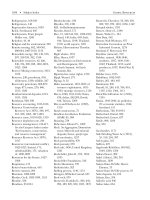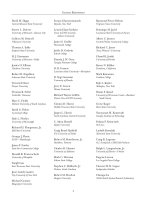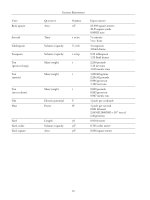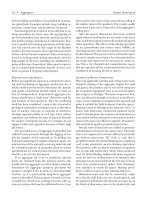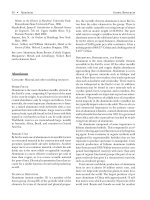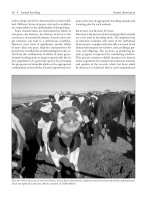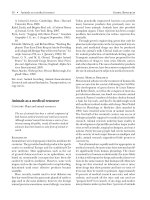Encyclopedia of Global Resources part 22 potx
Bạn đang xem bản rút gọn của tài liệu. Xem và tải ngay bản đầy đủ của tài liệu tại đây (279.3 KB, 10 trang )
C
Na
2
CO
3
C
2H
2
O), hydromagnesite (Mg
5
(CO
3
)
4
(OH)
2
C
4H
2
O), and artinite (Mg
2
(CO
3
)(OH)
2
C
3H
2
O).
The most abundant carbonate mineral is calcite
(CaCO
3
), which comprises limestone, chalk, traver-
tine, tufa (sedimentary rocks), and marble (meta-
morphic rock). Most limestone forms in warm, shal-
low seas, far from sources of land-derived sediment.
Chalk is made of the shells of microscopic floating or-
ganisms which once lived in the sea. Spring deposits
are travertine or tufa, and cave deposits (stalactites
and stalagmites) are travertine. These deposits form
from the evaporation of groundwater carrying dis-
solved calcium carbonate. Marble is limestone which
has been changed by heat and pressure. Malachite
and azurite are associated with the oxidized portions
of copper deposits and with copper veins through
limestone deposits.
Sodium carbonate minerals are present in associa-
tion with dry salt lake deposits in some parts of the
world. Theseinclude trona, natron (Na
2
CO
3
C
10H
2
O),
thermonatrite (NaCO
3
C
H
2
O), nahcolite (NaHCO
3
),
gaylussite (CaCO
3
C
Na
2
CO
3
C
5H
2
O), pirssonite (CaCO
3
C
Na
2
CO
3
C
2H
2
O), and shortite (2CaCO
3
C
Na
2
CO
3
).
History
Calcite, because of its abundance, has a rich history.
Because calcite can preserve fossil records, its pres-
ence helps datecultural artifacts. Chalkhas been used
for writing for thousands of years.
Obtaining Carbonate Minerals
The mostimportant use of calcite isin the production
of cements and lime. When limestone is heated to
about 900° Celsius, it loses CO
2
and is converted to
quicklime or lime (CaO). Mixed with sand, quicklime
forms mortar. When mixed with water, it hardens
or “sets,” swelling and releasing heat. The most widely
produced cement is portland cement (used in con-
crete), which is generally made from limestone and
silica- and alumina-bearing material such as clay or
shale. The raw materials are ground together, and
the mixture is heated in a kiln until it fuses into a
“clinker,” which is then crushed to a powder.
Uses of Carbonate Minerals
Lime (CaO) is also used in agriculture to neutralize
acid in soils, in the manufacture of paper, glass, and
whitewash, and in tanning leather. It is used in refin
-
ing sugar,as a watersoftener, and asa fluxfor smelting
various typesof ores. Fine-grained limestone has been
used in lithography (printing). Blocks of cut lime
-
stone and marble are usedas building stone and orna-
mental stone and may be polished. Crushed lime-
stone is used as aggregate in concrete and as road
metal. Dolomite has uses similar to those of calcite.
Several carbonates are metal ores: dolomite and
magnesite (ores of magnesium), rhodochrosite (man-
ganese), siderite(iron), smithsonite (zinc), strontian-
ite (strontium), witherite (barium), cerrusite (lead),
malachite and azurite (copper),andtrona (sodium).
Magnesite is used in the manufacture of refractory
materials capable of withstanding high temperatures,
for special types of cements, and in the paper, rubber,
and pharmaceutical industries. Strontianite is also
used in the manufacture of fireworks, producing a
purplish-red flame. Malachite (green) and azurite
(blue) are used as pigments. Sodium carbonate and
sodium bicarbonate are important in the manufac-
ture of washing soda (or sal soda) and are used as
cleaning agents and water softeners. They are used in
the manufacture of glass, ceramics, paper, soap, and
sodium-containing compounds (such as sodium hy-
droxide) as well as in petroleum refining. Sodium bi-
carbonate, also known as baking soda, is an important
part ofbaking powder, isa source ofcarbon dioxide in
fire extinguishers and is used medicinally to neutral-
ize excess stomach acid. Several carbonates are used
as ornamental stone and in jewelry, including mala-
chite, azurite, aragonite (alabaster), rhodochrosite,
and smithsonite.
Pamela J. W. Gore
Further Reading
Klein, Cornelis, and Barbara Dutrow. The Twenty-third
Edition of the Manual of Mineral Science. 23d ed.
Hoboken, N.J.: J. Wiley, 2008.
Pellant, Chris. Rocks and Minerals. 2d American ed.
New York: Dorling Kindersley, 2002.
Pough, Frederick H. A Field Guide to Rocks and Min-
erals. Photographs by Jeffrey Scovil. 5th ed. Boston:
Houghton Mifflin, 1996.
Tegethoff, F. Wolfgang, Johannes Rohleder, and
Evelyn Kroker, eds. Calcium Carbonate: From the Cre-
taceous Period into the Twenty-first Century. Boston:
Birkhäuser Verlag, 2001.
Tucker, Maurice E., and V. Paul Wright. Carbonate
Sedimentology. Boston: Blackwell Scientific, 1990.
Warren, John K. Evaporite Sedimentology: Importance in
Hydrocarbon Accumulation. Englewood Cliffs, N.J.:
Prentice Hall, 1989.
180 • Carbonate minerals Global Resources
Web Site
Carbonate-hydroxylapatite Mineral Data
/>hydroxylapatite.shtml
See also: Carbon cycle; Crystals; Evaporites; Lime;
Limestone; Minerals, structure and physical proper-
ties of; Sedimentary processes, rocks, and mineral de-
posits.
Carnegie, Andrew
Category: People
Born: November 25, 1835; Dunfermline, Scotland
Died: August 11, 1919; Lenox, Massachusetts
Carnegie established the Carnegie Steel Company,
which he eventually sold for $250 million. The explo-
sive growth of the steel industry that Carnegie’ssuccess
exemplified initiated the final phase of the Industrial
Revolution; it ultimately led, for example, to the mass
production of automobilesand the exploitationof a va-
riety of resources worldwide.
Biographical Background
In 1848, Andrew Carnegie moved from Scotland to
the United States. He began working in an Allegheny,
Pennsylvania, cotton millfor $1.20 perweek. Later, he
moved to Pittsburgh, becoming involved in the rap-
idly growing railroad business. Carnegie soonbecame
the superintendent of the Pittsburgh division of the
Pennsylvania Railroad. By investing wisely in what be-
came the Pullman Company and in oil lands, Carne-
gie established the foundation for his fortune.
Impact on Resource Use
Following service in the War Department during the
Civil War, Carnegieleftthe Pennsylvania Railroad and
formed acompany to build iron railroad bridges.This
led to the next step: the production of steel. He
founded a steel mill and began using the new Besse-
mer process of makingsteel. The extensive useof steel
that resulted from Carnegie’s work led to a greater ex-
ploitation of iron ore deposits in the United States
and abroad. The need for oil and rubber, which grew
alongside the booming steel industry, also acceler
-
ated resource exploitation and had profound effects
on succeeding generations.
By 1899, the Carnegie Steel Company controlled
25 percent of steel production in the United States.
Two years later, Carnegie sold the company to J. P.
Morgan, whoorganized it into the U.S.Steel Corpora-
tion, the first billion-dollar corporation in the United
States.
When Carnegie was thirty-three years old, with an
annual income of fifty thousand dollars, he declared
that a person should never seek to build a fortune un-
less intending to give the surplus for benevolent pur-
poses. Although he did not always follow his own ad-
vice, he did eventually give more than $350 million to
philanthropic projects, including the endowment of
seventeen hundred libraries, the Tuskegee Institute,
and the Peace Palace at The Hague in the Nether-
lands.
Glenn L. Swygart
See also: Bessemer process; Capitalism and resource
exploitation; Iron; Steel; Steel industry.
Global Resources Carnegie, Andrew • 181
Andrew Carnegie was the leading figure in the steel industry at the
end of the nineteenth century. (Library of Congress)
Carson, Rachel
Category: People
Born: May 27, 1907; Springdale, Pennsylvania
Died: April 14, 1964; Silver Spring, Maryland
Carson made a major contribution to the environmen-
tal movement in the United States by educating the
public about the natural geological evolution of the
Earth and the dangers associated with the widespread
use of chemicals. Her book Silent Spring was pub-
lished in 1962.
Biographical Background
Rachel Carson was educated at the Pennsylvania Col-
lege for Women in Pittsburgh and Johns Hopkins
University in Baltimore, Maryland. She did research
at the Woods Hole Marine Biological Laboratory and
subsequently worked for the U.S. Fish and Wildlife
Service in Washington, D.C.
Impact on Resource Use
Carson published Under the Sea-Wind (1941); The Sea
Around Us (1951), which received the National Book
Award for nonfiction; The Edge of the Sea (1955); and
her most famous work, Silent Spring (1962). Her writ-
ings took a naturalist’s approach to explaining the
ocean environment and the origin of the Earth, and
they were praised for their clear explanations in lay
terms. The Edge of the Sea revealed Carson’s growing in-
terests in the interrelationshipsof Earth’s systems and
a holistic approach to human interaction with nature.
In Silent Spring Carson warned of the environmental
contamination that results from widespread use of pes-
ticides, particularly dichloro-diphenyl-trichloroethane
(DDT). She described how the ecology of the soil had
been largely ignored in the rush to apply chemicals,
drew attention to the effects on wildlife where chemi-
cal mixing in runoff channels turned streams into le-
thal cauldrons of chemical soup, and accused the
chemical companies of aggressive marketing policies
that ignored theimpact on the environment. The first
Earth Day (April 22, 1970) and the creation of the En-
vironmental Protection Agency in 1970 can both be
attributed inpart to Carson’s role in changing the way
Americans thought about their surroundings.
Pat Dasch
See also: Environmental movement; Food chain;
Pesticides and pest control.
Carter, Jimmy
Category: People
Born: October 1, 1924; Plains, Georgia
As the thirty-ninth president of the United States,
James Earl“Jimmy” Carter deregulated domestic crude
oil prices and established the Department of Energy.
Biographical Background
Jimmy Carter graduated from the United States Naval
Academy and served in the Navy until his father’s
death. Assuming his father’s business responsibilities,
Carter expanded the family business and ran for politi-
cal offices.Hewas elected governor ofGeorgia in 1970.
At the end of his term as governor, Carter began a cam
-
paign for the presidency. He ran against incumbent
Gerald Ford in 1976 and won by a narrow margin.
182 • Carson, Rachel Global Resources
Rachel Carson’s seminal text Silent Spring helped spearhead the
modern environmental movement. (Library of Congress)
Impact on Resource Use
The years before and during President Carter’s term
were times of instability in the world economy. World
petroleum demand was increasing, and Congress had
capped domestic crude oil prices, discouraging do-
mestic petroleum exploration. In 1979, the Organiza-
tion of Petroleum Exporting Countries (OPEC) raised
crude oil prices by 50 percent. Because most goods
were moved to market by gasoline- or diesel-powered
transport, theincrease in worldpetroleum prices con-
tributed significantly to inflation, which reached an
annual rate of 12 percent. Interest rates tracked infla-
tion and rose 20 percent,a level unprecedented in the
twentieth century.
In response to these problems, President Carter
proposed an energy program that included creation
of a Department of Energy, deregulation of domestic
crude oil prices, and promotion of conservation and
alternative energy sources. An advocate of environ
-
mentalism, President Carter was also successful in
obtaining congressional action that preserved vast
wilderness areas in Alaska.
Robert E. Carver
See also: Department of Energy, U.S.; Energy eco-
nomics; Oil embargo and energy crises of 1973 and
1979; Synthetic Fuels Corporation.
Carver, George Washington
Category: People
Born: July 12, 1861?; near Diamond Grove (now
Diamond), Missouri
Died: January 5, 1943; Tuskegee, Alabama
A pioneering African American agricultural scientist,
Carver is best known for popularizing and promoting
the economic potentialofpeanuts and sweet potatoesas
alternative crops for southern farmers.
Biographical Background
George WashingtonCarver was born intoslavery near
the end of the Civil War near Diamond Grove (now
Diamond), Missouri. His early education was spo-
radic, thoughhe did attend high school in Minneapo-
lis, Kansas. He was briefly a homesteader in Ness
County, Kansas, before he returned to school, first at
Simpson College inIndianola, Iowa, where hestudied
fine arts, then at Iowa State University in Ames, Iowa,
where he studied agriculture. AfterCarver completed
his bachelor of agriculture degree in 1894, he was ap-
pointed to the faculty at Iowa State and received a
master of agriculture degree in 1896.
Impact on Resource Use
Carver immediately began working as director ofagri-
culture and director of the agricultural experiment
station at Tuskegee University in Alabama. Carver
won international acclaim for the educational efforts
he began intheearly 1900’sto promote sound conser-
vation practices and sustainable agricultural activity
in the rural South, which had previously been depen-
dent on cotton production. He is best known, how-
ever, for popularizing and promoting the economic
potential of peanuts and sweet potatoes as alternative
crops for southern farmers. He was instrumental in
persuading Congress to protect the peanut industry
from foreign competition shortly after World War I.
Global Resources Carver, George Washington • 183
Jimmy Carter,thethirty-ninthpresident of the United States,wasan
early advocate of alternative energy use. (Library of Congress)
In the later stages of his career, he investigated the po-
tential uses of peanuts and sweet potatoes, which in-
cluded uses in dyes, milk substitutes, and cosmetics.
Mark S. Coyne
See also: Agricultural products; Agriculture indus-
try; Agronomy.
Cement and concrete
Category: Products from resources
Cement and concrete have played crucialroles in shap-
ing humankind’s physical environment. Of all manu-
factured construction materials worldwide, concrete is
the most widely used.
Background
Cement is an important construction material be
-
cause of the ready availability of its raw materials, its
capacity to be shaped prior to setting, and its durabil
-
ity after hardening. When combined with an aggre-
gate (such as sand, gravel, or crushed rock), cement
becomes concrete—a durable, load-bearing construc-
tion material.
Cements with the ability to set and harden under-
water are called hydraulic cements. The most com-
mon of these is portland cement, consisting of com-
pounds of lime mixed with silica, alumina, and iron
oxide. Gypsum isalsoadded to retard the settingtime.
When water is added, these ingredients react to form
hydrated calcium silicates that willset into a hardened
product.
History
Cement has been used for construction purposes for
the past six thousand years. The Egyptians are known
to have used a simple cement, and the Greeks and Ro-
mans advanced the technology by creating hydraulic
cements from various volcanic materials and lime.
Many examples of their concrete structures remain
today—some underwater, where they were used in
harbors.
The quality of cementing materials declined greatly
during the MiddleAges but began toimprove again in
the late eighteenth century. In 1756, the famed Brit-
ish engineer John Smeaton was commissioned to re-
build the Eddystone Lighthouse near Cornwall, En-
gland. He undertook a search for lime mortars that
would resist the action of the water and discovered
that the best limestone contains a high proportion of
clayey material. For his project he used lime mixed
with pozzolana from Italy (the same volcanic material
the Romans had used). Smeaton was followed by a
number of researchers, including Joseph Aspdin, a
Leeds builder, who patented “portland” cement,
named for the high-quality building stone quarried at
Portland, England.
Manufacturing Cement
Cement is a manufactured product, made from raw
materials that are found relatively easily in nature. Ce-
ment manufacturers have a number of sources for
lime, but the most common are limestone and chalk.
Coral and marine shell deposits are also used as
sources of lime, when available. Silica, alumina, and
iron oxide are found in clays, shales, slates, and cer-
tain muds. Some raw materials contain almost all the
ingredients of cement, especially marl (a compact
clay), cement rock, and blast-furnace slag. Industrial
184 • Cement and concrete Global Resources
Scientist George Washington Carver is best known for his work with
agricultural crops such as peanuts. (National Archives)
Global Resources Cement and concrete • 185
Data from the U.S. Geological Survey, . U.S. Government Printing Office, 2009.Source: Mineral Commodity Summaries, 2009
40,000,000
37,000,000
36,000,000
35,000,000
35,000,000
33,000,000
30,000,000
30,000,000
22,000,000
Metric Tons
1,500,000,0001,250,000,0001,000,000,000750,000,000500,000,000250,000,000
Saudi Arabia
Thailand
Iran
Indonesia
Vietnam
Mexico
Germany
Pakistan
France
Egypt
Italy
Turkey
Brazil
Spain
South Korea
Russia
Japan
United States
India
China
40,000,000
47,000,000
48,000,000
48,000,000
55,000,000
56,000,000
61,000,000
67,000,000
89,100,000
175,000,000
1,450,000,000
Cement: Top Producers, 2008
wastes such as fly ash and calcium carbonate are also
used as raw materials for cement, but not on a large
scale.
Raw materials in the form of hard rock—such as
limestone, slate, and some shales—are usually quar-
ried, but they may also be mined. If the limestone is of
low quality, it may need to go througha concentrating
process. Softer materials such as chalk, clay, and mud
can be dug by various types of machinery, depending
on the physical setting and type of material. Once ex-
tracted, the raw materials are transported to the ce-
ment manufacturing plant by truck, rail, conveyor
belt, or pipeline (when in a slurry).
At the plant, the raw materials are ground into a
fine powder and then mixed in predetermined ratios.
The mixing can be done wet, semidry, or dry. In the
wet process the materials are ground wet and mixed
into a slurry. In the semidry process they are ground
dry, then moistened for adhesion; and in the dry pro-
cess the raw materials remain dry throughout.
After mixing, theraw materials are burnedin a large
rotating kiln. Kilns are usually from four to eight me-
ters in diameter and from 90 to 200 meters long, and
they consist of a steel cylindrical shell inclined slightly
from the horizontal. The mixture is introduced at the
upper end of the kiln, and as it flows
down the incline (with the help of
gravity and the kiln’s steady rotation),
it reaches a maximum temperature
between 1,300° Celsius and 1,500°
Celsius, at which point the raw mate-
rials interact to form calcium sili-
cates. The heated material exits the
kiln in the form of rough lumps or
pellets—called clinker—no larger
than 5 centimetersindiameter. After
the clinker cools, the manufacturer
adds gypsum and grinds the mixture
into the fine powder known as port-
land cement.
Uses of Concrete
Concrete is generally used in four
common forms: ready-mixed, pre-
cast, reinforced, and prestressed.
Ready-mixed concrete is transported
to a construction site as a cement
paste and is then poured into forms
to make roadways, foundations,
driveways, floor slabs, and much
more. Precast concrete—cast at a plant and then
transported to the site—is used for everything from
lawn ornaments to major structural elements. Rein-
forced concrete is created by adding steel mesh, rein-
forcing bars, or any other stiffening member to the
concrete before it sets. Prestressed concrete, the most
recently developed form, increases the strength of a
beam by using reinforcing steel to keep the entire
beam under compression. Concrete is much stronger
under compression (pushed in on itself) than under
tension (pulled apart).
Brian J. Nichelson
Further Reading
Gani, M.S. J. Cement and Concrete. New York: Chapman
& Hall, 1997.
Lea, F. M. Lea’s Chemistryof Cement and Concrete. 4th ed.
Edited by Peter C. Hewlett. New York: J. Wiley,
1998.
Mehta, P. K., and Paulo J. M. Monteiro. Concrete:
Microstructure, Properties, and Materials. 3d ed. New
York: McGraw-Hill, 2005.
Mindess, Sidney, J. Francis Young, and David Darwin.
Concrete. 2d ed. Upper Saddle River, N.J.: Prentice
Hall, 2003.
186 • Cement and concrete Global Resources
Source: Mineral Commodity Summaries,
2009
Data from the U.S. Geological Survey,
. U.S. Government Printing Office, 2009.
Ready-mix
concrete
75%
Concrete
products
13%
Contractors
(road paving) 6%
Building material dealers 3% Other 3%
U.S. End Uses of Cement
Neville, A. M. Properties of Concrete. 4th ed. Harlow,
Essex, England: Longman Group, 1995.
Web Sites
Natural Resources Canada
Canadian Minerals Yearbook, Mineral and Metal
Commodity Reviews
/>indu/cmy-amc/com-eng.htm
Portland Cement Association
Cement and Concrete Basics
/>U.S. Geological Survey
Cement: Statistics and Information
/>commodity/cement/index.html#mcs
See also: Clays; Gypsum; Lime; Limestone; Sand and
gravel; Shale; Silicates; Slate.
Central Arizona Project
Category: Organizations, agencies, and programs
Date: Established September 30, 1968; substantially
completed 1993
The Central Arizona Project (CAP), a series of pump-
ing plants, dams, aqueducts, and pipelines stretching
more than 540 kilometers, is the largest water transfer
project in the United States. Drawing water from Lake
Havasu has supported agriculture in southwest Ari-
zona and made possible the growth of major cities,
while harming several species of fish and animals
downstream.
Background
As the area that makes up the southwestern United
States was settled and populated by Europeans in the
nineteenth century, the need for more water became
apparent. In the early 1900’s, the Southwest looked to
the Colorado River basin as a source of water,and ase-
ries of laws and court decisions called the “Law of the
River” were established to ensure that each state was
treated equitably. Decades ofcourt cases attempted to
determine the amount of the water to which Arizona
was entitled. Through the 1950’s Arizona lobbied for
authorization of a Central Arizona Project, and the
U.S. secretary of the interior called for a comprehen
-
sive Colorado River plan to address the future water
needs of seventeen Western states. Passed on Septem-
ber 30, 1968, Public Law 90-537, 82 Stat. 885 created
the Colorado River Basin Project and the Lower Colo-
rado River Basin Development Fund, which autho-
rized in turn the development of the Dixie Project in
Utah and the Central Arizona Project in Arizona and
New Mexico.
Provisions
The Central Arizona Project was designed to move
4,000 square kilometers of water from Lake Havasu,
fed by the Colorado River, to agricultural lands in
Maricopa, Pima, and Pinel Counties in Arizona, and
to Catron, Grant, and Hidalgo Counties in New Mex-
ico. Because of high costs and lower-than-expected
demand, however, the New Mexico portion of the
project was never built. During the years of construc-
tion, the economy of Arizona began to shift from agri-
culture to industry, and the metropolitan areas of
Phoenix, Scottsdale, and Tucson experienced rapid
growth. As a result, CAP waters were reallocated, so
that over time more water would be designated for
municipal and industrial use,andless for agriculture.
Impact on Resource Use
The purpose of CAP, as it was conceived in the late
1940’s, was to keep agriculture thriving without de-
pleting groundwater supplies. By most accounts, this
goal was not realized. In addition, the diversion of
water from itsnatural course hascreated environmen-
tal problems downstream from Lake Havasu, includ-
ing the extinction of fish and wildlife, in spite of sev-
eral successful conservation efforts along the project
itself. Dams along the project provide hydroelectric
power, reducing the region’s dependence on other
forms of power generation.
Cynthia A. Bily
Web Sites
Central Arizona Project
/>U.S. Department of the Interior Bureau of
Reclamation
Colorado River Basin Project: Central Arizona
Project
/>Global Resources Central Arizona Project • 187
See also: Hydroenergy; Los Angeles Aqueduct; Three
Gorges Dam.
Ceramics
Category: Products from resources
Ceramics are inorganic, nonmetallic materials—such
as naturally occurring silicates, oxides, nitrates, car-
bonates, chlorides, and sulfates—that are subjected to
high temperatures during their manufacture and pro-
cessing. Ceramic materials are high strength but brit-
tle. As a result of modern research and development,
they have multiple and varied uses.
Background
Paradoxically, ceramic science is one of the oldest yet
one of the newest technologies. Much of what is
known of prehistoric humans and of the earliest civili-
zations has beenlearned fromthe pottery thatwas left
behind. This longevity illustrates one of the greatest
assets of ceramic materials, their durability. The fact
that most of the surviving pieces are fragments gives
evidence of the greatest weakness, their brittleness.
The term “ceramics” is derived from the Greek
term keramos, which means “potter’s clay.” Ceramics is
defined in some dictionaries as “the art of making
things from baked clay.” “Clay” is used in describing
ceramics because it was an essential material in tradi-
tional ceramic compositions. The term “baked” is im-
portant, since high temperatures are used in most
processing of ceramics. Althoughsimple, thisdescrip-
tion of ceramics was an accurate one until the time of
WorldWar II. In the early 1940’s, the field of materials
science, of which ceramics is a part, experienced a
push to develop new materials and processing meth-
ods. Today, a more accurate present-day description
of ceramics might be “the art and science of making
and using implements and other articles that are es-
sentially composed of inorganic and nonmetallic
compounds.”
Traditional Ceramics
The ceramic industries may be grouped into several
divisions according to the products produced. Tradi-
tional divisions include whitewares, refractories, abra
-
sives, structural clay products, glass, cement, and por
-
celain enamels. Developments in the second half of
the twentieth century in the fields of nuclear physics
and electronics resulted in many new ceramic prod-
ucts, collectively known as technical ceramics.
Whitewares are materials such as clay, feldspar,
whiting, and potter’s flint that fire to a white color.
The mineral mixtures are shaped and then partially
melted at high temperatures to produce a dense hard
material. The term whiteware is misleading, since
products in this class are produced in a wide variety of
colors, depending on the amounts of impurities in
the raw materials.Common whitewares includeearth-
enware, porcelain or other tableware products as well
as casseroles and bowls,floorand wall tile, anddecora-
tive products such as vases and lamp bases. Important
commercial whitewares include laboratory ware such
as porcelain crucibles, combustion tubes, and grind
-
ing balls for the chemist as wellas electrical porcelains
such as spark plugs and insulators.
188 • Ceramics Global Resources
A worker carries ceramic cylinders in Jungdezhen City,China, home
to what is believed to be the oldest egg-shaped ceramics kiln in the
world. (Zhang Wu/Xinhua/Landov)
Refractories are structural materialsmanufactured
for the purpose of withstanding corrosive high-tem-
perature conditions in furnaces and process vessels.
Refractories have high melting temperatures, good
hot strength, and resistance to chemical attack and
abrasion. They are made from the refractory clays, ka-
olin, magnesite,chrome ore, olivine, and bauxite. For
more special services, refractory products are made
from synthetic compositionssuch as carbidesand bor-
ides. Among the most important users of refractories
are the metallurgical industries, including the steel
industry.
Glasses are ceramics that do not return to crystal-
line form after being melted and cooled. These
noncrystalline ceramics behave as high viscosity liq-
uids. They are essentially rigid at room temperature
but gradually soften and flow as the temperature is in-
creased. This viscosity allows glasses to be formed by
processes that will not work for other ceramic materi-
als. Glasses can be pressed into shallow shapes, drawn
or rolled into tubes and sheets, blown into hollow
shapes, or spun into fibers.
Most glasses are naturally transparent to visible
light and are commonly used as windows, bottles,
lightbulbs, lenses, and optical fibers. The basic ingre-
dient in most glasses is silica sand, but a wide range of
other materials can be added to produce glasses pos-
sessing a wide variety of tailored properties. Borosili-
cate glasses are resistant to both chemicals and heat,
properties that make them useful both in the home
and in the laboratory. Oxides of the transition metals
may be added to produce glass of almost any desired
color.
The porcelain enamels are glassy coatings fused
onto metals to provide decoration and protection
from corrosion. They are hard, rigid ceramics that
are electrical and thermal insulators as well as wear-
resistant and chemically inert. Available in all colors,
they are found on household appliances, on struc-
tures used for food storage, in medical and hospital
equipment, and in vessels used in the production of
food and chemicals.
Technical Ceramics
Research after World WarII madepossible a wide vari-
ety of nontraditional ceramic products based onhigh-
purity synthetic materials processed by special tech-
niques. A few items will illustrate the scope of this
relatively new field.
Ceramics have played an essential role in the devel
-
opment of the computer industry. The ceramic pro
-
cess is used in the fabrication of the complex inte-
grated circuits that perform the basic operations of a
computer on silicon semiconductor wafers. These in-
tegrated circuits are packaged on ceramic substrate
materials.
Oxides and carbides of uranium, plutonium, and
thorium are ceramic materials that are used in the
production of fuels for nuclear fission reactors. High-
strength concrete, often containing lead, is used in
shielding structures around nuclear reactors. “Hot
cell” windows, made of leaded glass, maintain optical
transparency when exposed to radiation. Ceramic
materials are also used in virtually all segments of the
aerospace industry. Refractory materials are used in
building launching pads, rocket nozzles, and heat
shields.
Lasers, which came into prominence in the 1960’s,
utilize the variousquantum transitions thatatoms and
molecules undergo to produce intense beams of in-
frared, visible, or ultraviolet light. The original ruby
laser used as its light-emitting medium a crystalline
aluminum oxide ceramic that contained a small
amount of chromium. Another important ceramic la-
ser is the yttrium aluminum garnet doped with neo-
dymium to emit light in the infrared region of the
spectrum. As the need for more specialized materials
grows, the field of ceramic science will continue to
produce more and more exotic materials.
Grace A. Banks
Further Reading
Barsoum, M. W. FundamentalsofCeramics. Rev.ed.Phil-
adelphia: Institute of Physics, 2003.
Bormans, P. Ceramics Are More than Clay Alone: Raw Ma-
terials, Products, Applications. Cambridge, England:
Cambridge International Science, 2003.
Carter, C. Barry, and M. Grant Norton. Ceramic Mate-
rials: Science and Engineering. New York: Springer,
2007.
Jones, J. T., and M. F. Berard. Ceramics Industrial Pro-
cessing and Testing. 2d ed. Ames: Iowa State Univer-
sity Press, 1993.
McColm, Ian J. Dictionary of Ceramic Science and Engi-
neering. 2d ed. New York: Plenum Press, 1994.
Phillips, George C. A Concise Introduction to Ceramics.
New York: Van Nostrand Reinhold, 1991.
Sfmiya, Shigeyuki, et al., eds. Handbook of Advanced Ce
-
ramics. 2 vols. Boston: Elsevier/Academic Press,
2003.
Global Resources Ceramics • 189
